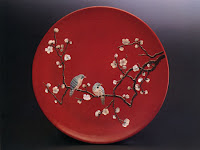

Today i went to a typical tea ceremony on a local Spring Festival. You probably already know that tea ceremony which is very popular in Japan, was actually introduced from China. The way of conducting tea ceremony was later on perfected by Master Sen-no-Rikkyu based on the spirit of Zen during the 16th century.

Do you know why you have to turn the cup twice (clockwise) before you drink the tea?
* Apparently when the tea master serves your tea, the cup facing you is supposedly to be the best side of the cup, i.e. note that cups used in tea ceremony usually has elaborated design. This is a way of showing respect towards the guest. However, the reason why you turn in twice (clockwise) is for you to return the respect towards the tea master, i.e. by showing the best side of the cup towards the tea master.
Do you know why you have to turn the cup once (anti-clocwise) after you finish drinking your tea, just before you place the empty cup on the tatami?
* By turning it once anti-clockwise the best side of the cup should face the person next to you, thus showing respect towards the other guests.
What do you say to the other guests, facing the person next to you, before drinking your tea?
* O-saki ni (excuse me, may i drink this tea before you?) - this is to show politeness towards the other guests who have not had their turns.

Do you know why "quietness", "stillness" and "observation" are the key to enjoy tea ceremony? * Tea ceremony as the words say, is not just a way of enjoying tea, but a ceremony of a mental discipline for the purpose of achieving peaceful mind - the profound teaching of Zen. In quietness and stillness you can observe the way of tea making, the sound of water, the movement and enjoy how each season is portrayed differently in ways of presentation, such as in the use of cups, color of kimono, tools used in the ceremony and seasonal Japanese sweets.
Nowadays, tea ceremony is not only known in Japan but internationally such as in the US and Europe. Some people may consider tea ceremony a rather uptight activity as it involves a lot of procedures and rules. The truth is it is understandable for beginners not to know some of the rules and the tea master, in most cases, will explain to beginners in details on "what to do" during tea ceremony.
Finally to lighten up, check out below a Japanese TV program showing a magic performance conducted during a tea ceremony, ... something rare. Enjoy!

 Source: An English Introduction To Japan and Its People, published by ALC --> a very good book for those interested in Japan and Japanese culture
Source: An English Introduction To Japan and Its People, published by ALC --> a very good book for those interested in Japan and Japanese culture

 Japanese summer calls for activities with a cooling effect, such as:
Japanese summer calls for activities with a cooling effect, such as:

 Nowadays, i learnt that although many Japanese do not claim themselves to be Buddhist, they actually perform Buddhist customs with respect to honoring the spirits of ancestors. Mid August is the period where people here celebrates Bon Festival, a festival honoring the deceased, which was originally called the Feasts of Lanterns. In the past during this festival people would dance, called a Bon Odori.
Nowadays, i learnt that although many Japanese do not claim themselves to be Buddhist, they actually perform Buddhist customs with respect to honoring the spirits of ancestors. Mid August is the period where people here celebrates Bon Festival, a festival honoring the deceased, which was originally called the Feasts of Lanterns. In the past during this festival people would dance, called a Bon Odori.











 This may be quite an embarrasing note, but frankly it was only recently that i found out how the word June Bride came around. The name June came from the Roman myth, June was the name of a Goddess who unite a couple into a marriage. The story telling said that getting married in June will bring happiness to the couple. In the past getting married in June was common in Europe, because in the region where Catholics were the majority, spring was a season for celebration and spring called for a big Easter celebration that took place during March to May. In June people are less busy with their religious commitment, so couples chose this blessed month to get married.
This may be quite an embarrasing note, but frankly it was only recently that i found out how the word June Bride came around. The name June came from the Roman myth, June was the name of a Goddess who unite a couple into a marriage. The story telling said that getting married in June will bring happiness to the couple. In the past getting married in June was common in Europe, because in the region where Catholics were the majority, spring was a season for celebration and spring called for a big Easter celebration that took place during March to May. In June people are less busy with their religious commitment, so couples chose this blessed month to get married.


 Today i was surprised by a flock of birds chirping noisily as i had my morning tea alone. I looked out into the garden and saw about 10 little birds flying back and forth from one tree in my garden to various spots around it. They seemed to be eating something, so i watched closely.
Today i was surprised by a flock of birds chirping noisily as i had my morning tea alone. I looked out into the garden and saw about 10 little birds flying back and forth from one tree in my garden to various spots around it. They seemed to be eating something, so i watched closely. 



 Every year in early May, Japanese have about a week of public holiday called the Golden week. The publich holiday itself occurs on April 29th which is the Showa Day, then May 3 which is the Foundation Day, May 4th which is the Green (Environment) Day and May 5th which is the Children Day. Like this year, when May 3rd public holiday falls on a Sunday, the government added May 6th as a replacement holiday. In most cases these consecutive public holidays together with a weekend creates just about a week holiday, that way the Japanese get to take longer holiday.
Every year in early May, Japanese have about a week of public holiday called the Golden week. The publich holiday itself occurs on April 29th which is the Showa Day, then May 3 which is the Foundation Day, May 4th which is the Green (Environment) Day and May 5th which is the Children Day. Like this year, when May 3rd public holiday falls on a Sunday, the government added May 6th as a replacement holiday. In most cases these consecutive public holidays together with a weekend creates just about a week holiday, that way the Japanese get to take longer holiday. 
 In Japan most houses are made of woods and it has been since the Edo era (1603 - 1867). Nowadays more and more people live in apartment buildings, however the presence of woods and timber, used for housing and Japanese papers, remains critical to Japanese lifestyle. Forests in Japan covers about 66% of the whole land, which is the largest ratio among developed countries.
In Japan most houses are made of woods and it has been since the Edo era (1603 - 1867). Nowadays more and more people live in apartment buildings, however the presence of woods and timber, used for housing and Japanese papers, remains critical to Japanese lifestyle. Forests in Japan covers about 66% of the whole land, which is the largest ratio among developed countries.

 Today i went to a typical tea ceremony on a local Spring Festival. You probably already know that tea ceremony which is very popular in Japan, was actually introduced from China. The way of conducting tea ceremony was later on perfected by Master Sen-no-Rikkyu based on the spirit of Zen during the 16th century.
Today i went to a typical tea ceremony on a local Spring Festival. You probably already know that tea ceremony which is very popular in Japan, was actually introduced from China. The way of conducting tea ceremony was later on perfected by Master Sen-no-Rikkyu based on the spirit of Zen during the 16th century.










 Some people here believe that the origin of
Some people here believe that the origin of 


 Sakura or the cherry blossom is the national flower of Japan and is considered by most Japanese their favorite flowers. Spring is the time for Hanami where Japanese gather and held parties in the open air under the cherry blossoms. It is more like having picnic out in the park, except that during cherry blossoms season, most parks are filled with people doing various activities other than just having picnics.
Sakura or the cherry blossom is the national flower of Japan and is considered by most Japanese their favorite flowers. Spring is the time for Hanami where Japanese gather and held parties in the open air under the cherry blossoms. It is more like having picnic out in the park, except that during cherry blossoms season, most parks are filled with people doing various activities other than just having picnics.
